Car Passenger Mode
New from BRO software version 22.5.9.
This function is available only from BRO software version 22.5.9. This mode is not available on BROs with earlier software versions. Please perform an update.
Recommended pelvic belt
We recommend a certified pelvic belt measuring at least 320 cm in length (XL version, e.g. Art-Nr. H 450 198 made by AMF Bruns). The pelvic belt is attached to the vehicle’s restraint system directly. Since not all driving services carry an XL version of the belt aboard every vehicle, we recommend that you take one with you.
The car passenger mode is used to travel as a passenger in an authorised vehicle while remaining seated in BRO. It is important to distinguish between two types of vehicles when using the car passenger mode (see Figure 71, “Types of vehicles when using the car passenger mode”):
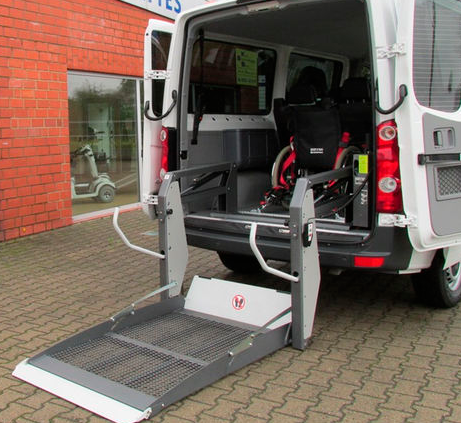 (a) Lifting platform | 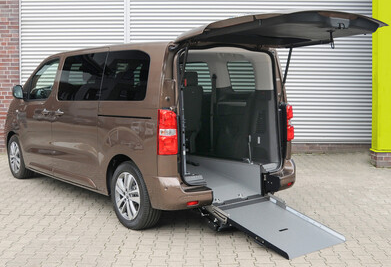 (b) Tailgate |
Vehicles with lifting platform / flatbed vehicles / vans (e.g. Mercedes Sprinter) → Use the car passenger position (see Vehicles with lifting platforms / buses )
Vehicles with tailgate: For vehicles with a tailgate, a relatively steep ramp has to be ascended facing forward. → First use the car passenger boarding mode followed by the car passenger position. See Vehicles with a Tailgate
Boarding vehicles using other boarding aids may be hazardous
Entering vehicles using the car passenger mode was tested on the above-mentioned vehicle types (lifting platform, tailgate). Boarding vehicles with other boarding aids may be hazardous and must be tested thoroughly every time with the assistance of people who will secure the wheelchair. In particular steep folding ramps, ramps with gaps, steps and thresholds can cause the device to topple forwards or backwards.
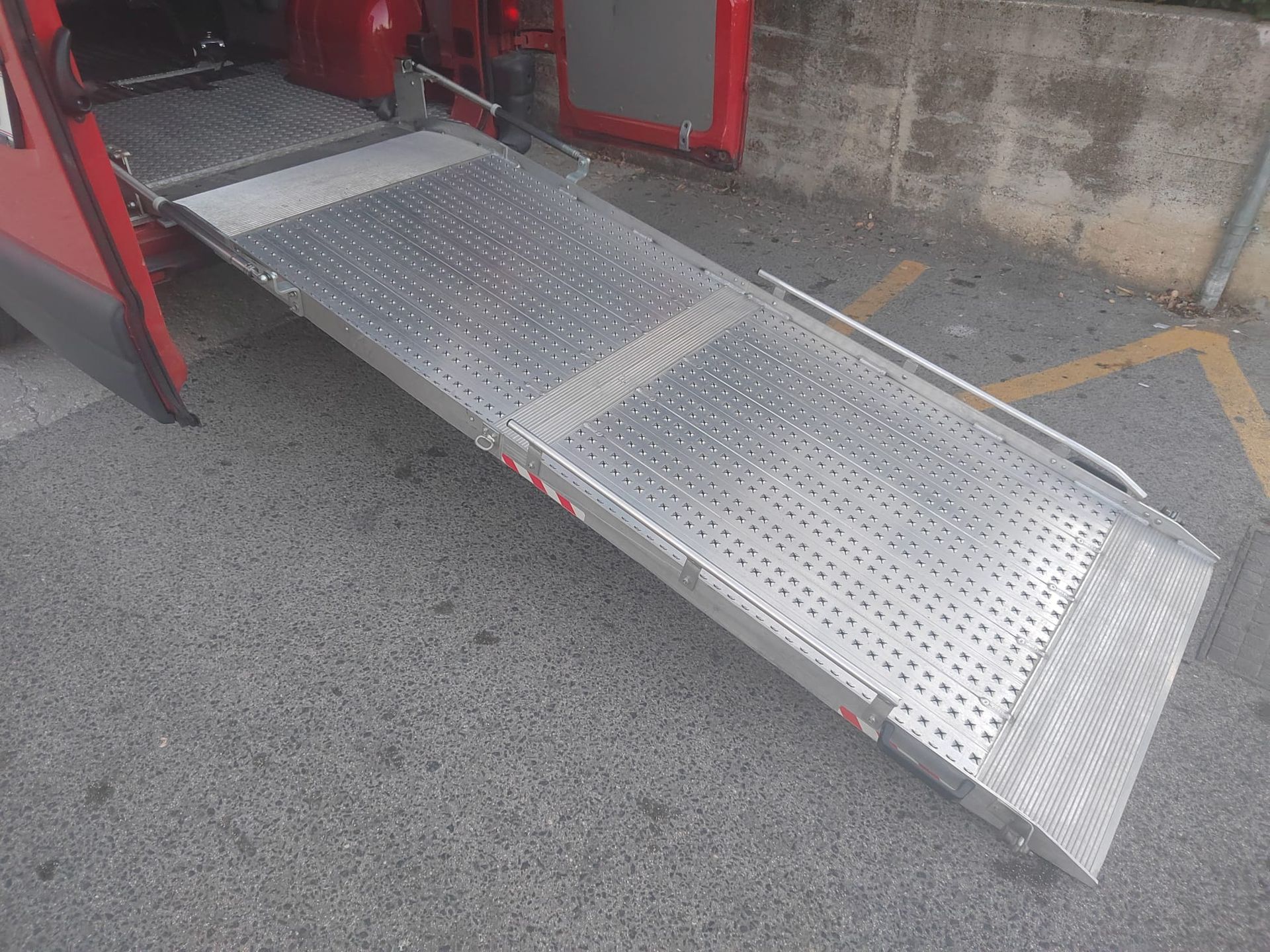 |
The following images show how the restraint belts are correctly attached to the wheelchair. For the rear securement Scewo recommends four belts (in addition to the two in the front), which comply with ISO 10542-1 and were tested with at least 160 kg each:
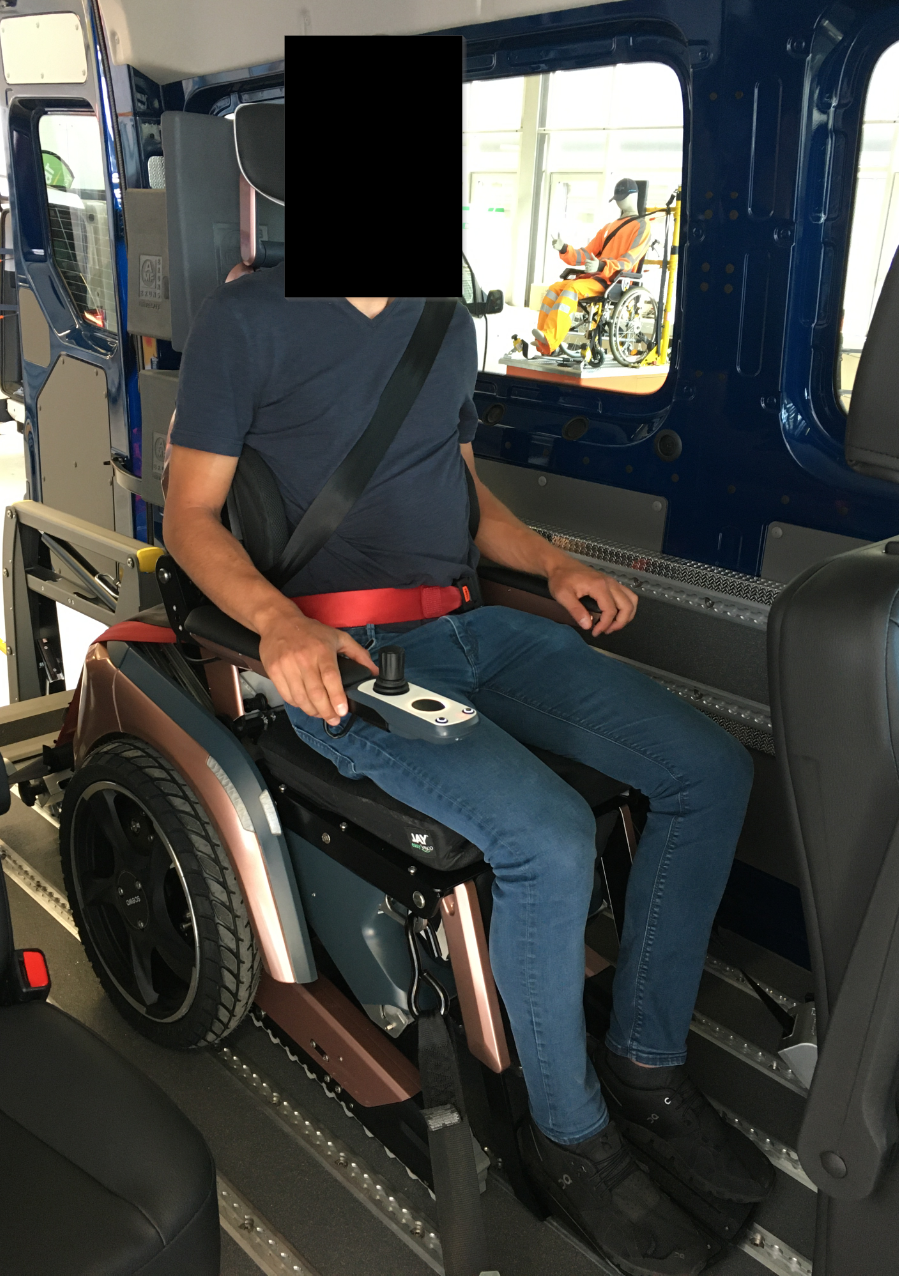 (a) General view | 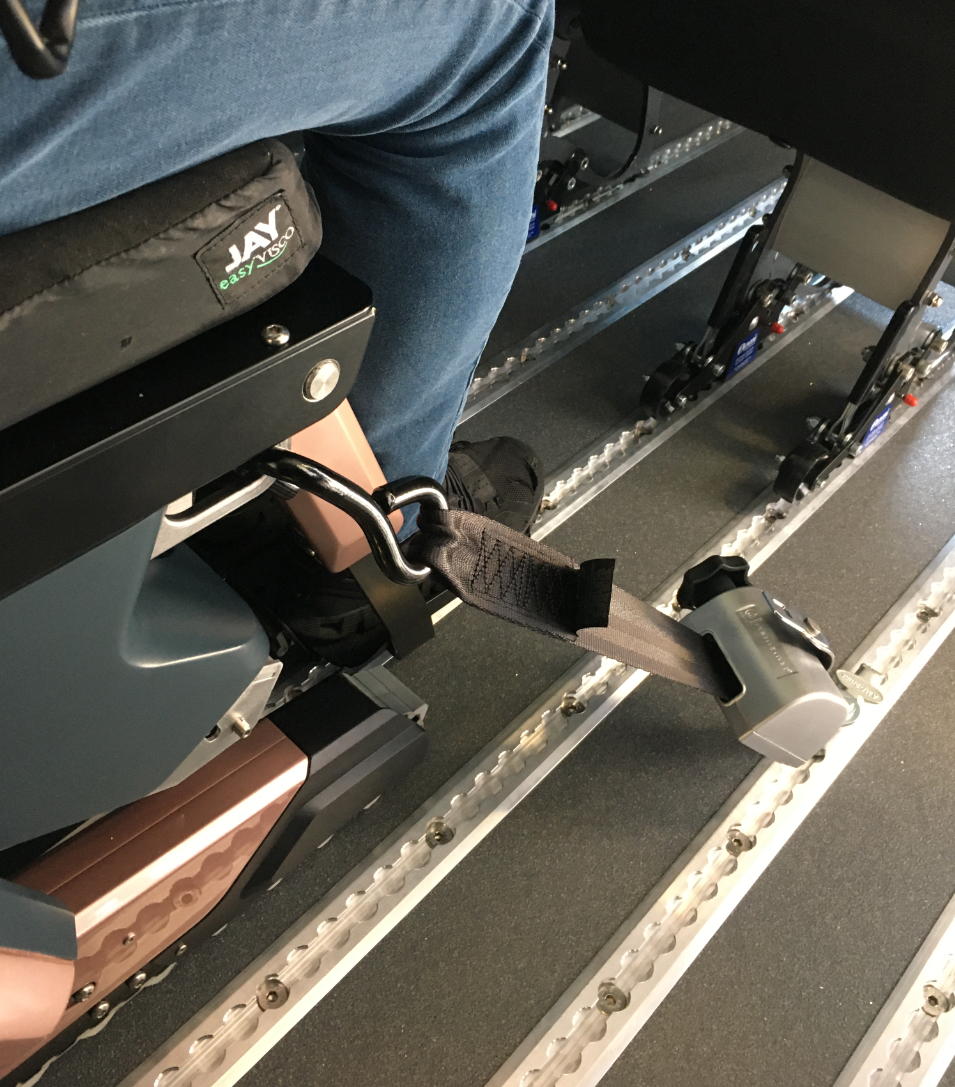 (b) Front detail | 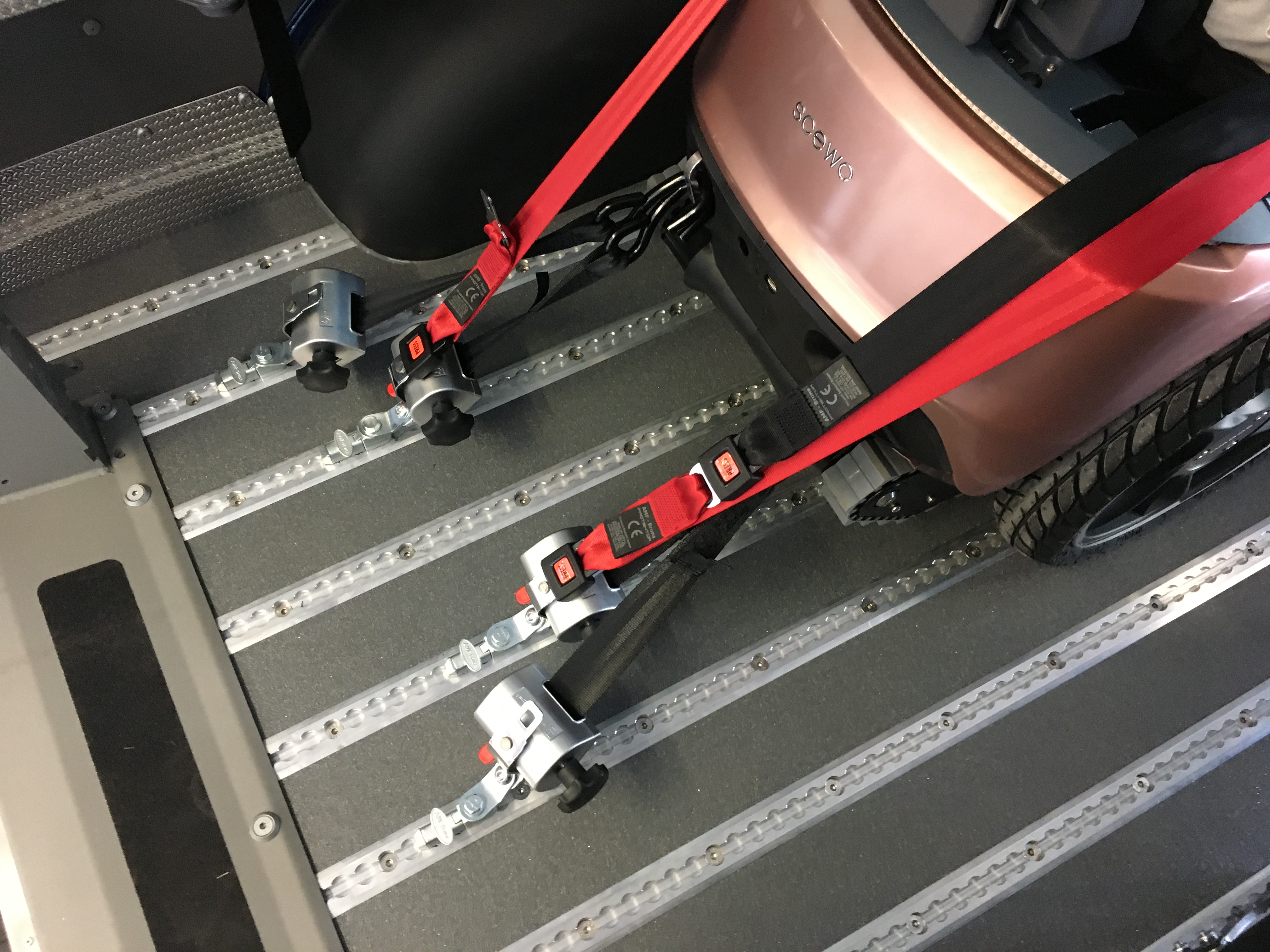 (c) Rear detail |
General safety instructions for transporting the wheelchair as a passenger seat in a car
When used as a passenger seat in a motor vehicle, the wheelchair may be transported facing forwards only.
The vehicle must be appropriately designed, insured and equipped to transport a wheelchair user. If the wheelchair is transported as a passenger seat in a vehicle, the vehicle must comply with the requirements of ISO 7176-19:2008.
If at all possible, you should use the vehicle’s designated seating and stow the wheelchair securely in the storage area (as outlined in Section Transporting the Wheelchair in the Car). No matter how securely a wheelchair is secured in the vehicle, it is not designed to be a car seat and cannot provide the same level of safety as standard car seats.
Before the transport, check that the wheelchair has been secured correctly and that both brakes are locked. Secure the wheelchair at the front and rear and only at the attachment points (marked by stickers) to the vehicle. Follow the manufacturer's instructions provided with the approved tie down belts.
Only use wheelchair accessories that are approved for use in a vehicle (e.g. back cushions). Remove any accessories that are not approved prior to transport.
Make sure that no components of the wheelchair accidentally press the release button of the belt buckle or brake.
If the wheelchair is involved in a road traffic accident, it must be returned immediately to the reseller or the manufacturer for inspection. The safety of its operation, and in the event of another accident, cannot be guaranteed.
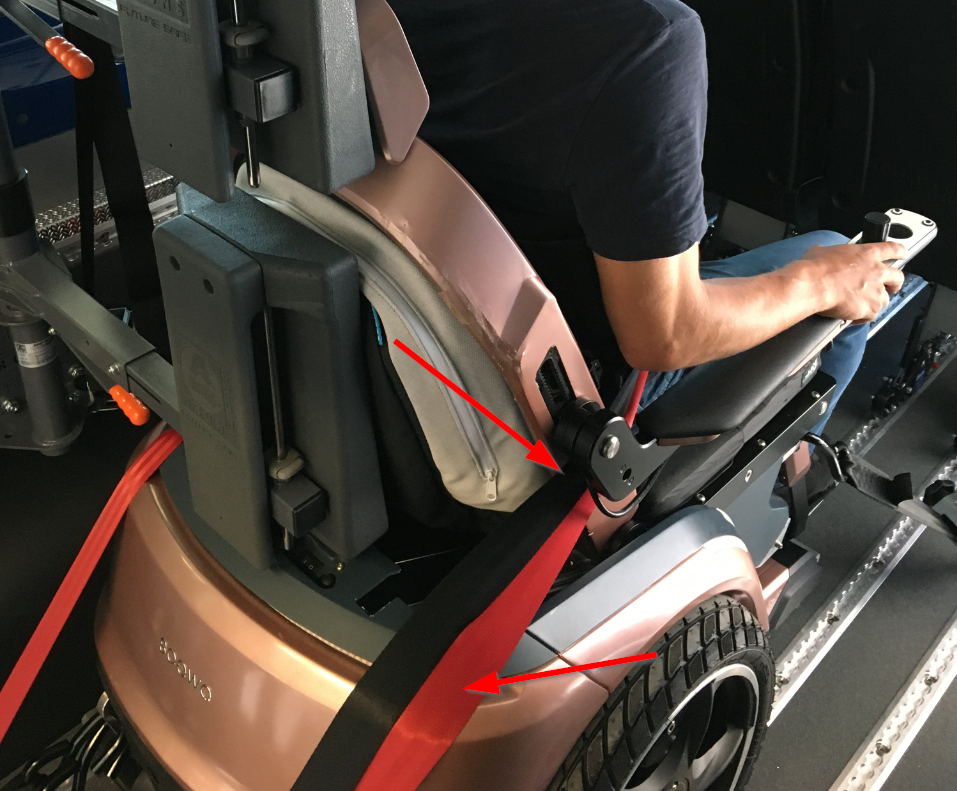 |
The following instructions must be followed when the wheelchair is in car passenger mode:
Use restraint belts that are strong enough and have been tested!
Scewo recommends using a total of six restraints, each with a test load of at least 160 kg (in accordance with ISO 10542-1). Two of these restraints should be attached to the wheelchair's rear securements points on each side before being secured to the vehicle. This is indicated with a “2x” sign on the label (see Figure 5, “Securement point label”). A total of only four restraints are is adequate for many restraint belt manufacturers
The pelvic belt or other aids are not a replacement for the three-point safety belt
The wheelchair positioning belts and aids are intended to position the user in the wheelchair so that it can be used safely. Wheelchair positioning belts and aids do not provide protection in the event of a traffic accident and cannot replace the seat belt installed in the vehicle.
Therefore, always use the restraint systems provided by the vehicle, preferably a three-point seat belt. The pelvic belt integrated into the wheelchair is not approved or designed for use in a vehicle and can break in the event of an accident! This is additionally highlighted by the inscription on the integrated belt, see Figure 6, “Do not use integrated pelvic belt in vehicles”.
Never use non-designated securement points
Only use the wheelchair’s labelled securement points to secure it to the vehicle and never use anything else like the wheel or tracks for this purpose. The securements points are indicated as shown in Figure 5, “Securement point label”. Do not modify the securement points and inform your reseller or Scewo if any of them are damaged.
Fasten the seat belt correctly
The correct position of the three-point seat belt is on the inside of the wheelchair’s arm support. The three-point seat belt must fit snugly against the occupant’s body with nothing obstructing it. Failure to position the three-point seat belt correctly may result in injury and/or death if the vehicle is involved in an accident.
Car passenger mode – use recommended position
It is essential that the wheelchair is in the designated car passenger position. This is indicated when the green car passenger mode icon lights up (see (b) Car passenger position – recommended position [93] ). If the correct positioning cannot be fully achieved, it is not possible to guarantee safety in the event of an accident and the device could detach from the restraints and injure or even kill the wheelchair user or other occupants.
Always use the car passenger mode in the direction of travel
If the wheelchair is used as a passenger seat in a vehicle, it MUST face the direction of travel. It is NOT permitted for the wheelchair to face any other direction (e.g. to the side or backwards) as this is dangerous for the occupant and other passengers. Safety in the event of an accident is only guaranteed if the wheelchair is secured in the direction of travel.
Unlock front restraint belts before driving out
The front restraint belts attached to the wheelchair must be unlocked (but not removed from the wheelchair) before driving out. Pulling on the locked straps can cause damage to the wheelchair or the attachment system.
Car passenger boarding mode - never use without front restraint belts and a third person (risk of tipping over)
Never use the car passenger boarding mode (see (a) Passenger boarding mode [93]), without two self-locking restraint belts attached to the two front securement points and an assistant standing behind the wheelchair. The assistant must be able to support the wheelchair from behind if required (risk of toppling over backwards).
Secure loose objects, remove smartphone from its holder before driving
Remove your smartphone from the Scewo holder before setting off. In the event of an accident, it could become a projectile and injure other occupants. Remove all other loose accessories or those that are not firmly and safely attached to the wheelchair